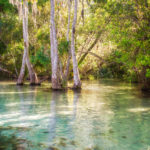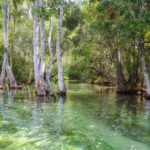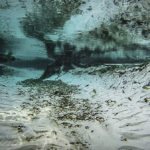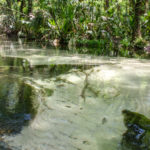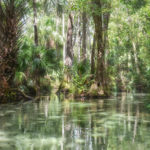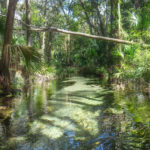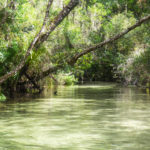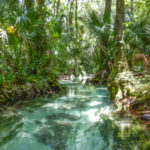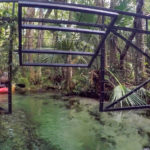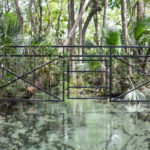Exploring Florida’s Navigable Waterways and Paddlers’ Rights
written and researched by James Steele
In the paddling community, many of us encounter situations involving private property, navigable waterways, and the rights of paddlers. This article examines the historical context of Florida’s Public Trust Doctrine concerning navigable waters, with a specific focus on the rights of paddlers on Florida’s Navigable Waterways. Additionally, it addresses legal considerations surrounding the obstruction of spring runs and provides an exploration of paddlers’ rights, especially when confronted by private property owners hindering access to these natural waterways. I hope you will find this article useful in your understanding of paddlers’ rights…James
HISTORICAL PERSPECTIVE ~ BLOCKING SPRING RUNS ~ FLORIDA COURT CASES ~PADDLERS’ RIGHTS ~ FAQs
Introduction
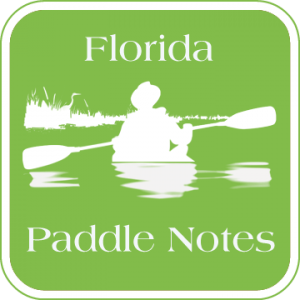 Florida’s geographical and recreational identity is intricately tied to its navigable waterways. Furthermore, the state’s extensive network of rivers, lakes, and coastal water bodies offers diverse opportunities for recreation, such as kayaking, canoeing, and paddleboarding.
Florida’s geographical and recreational identity is intricately tied to its navigable waterways. Furthermore, the state’s extensive network of rivers, lakes, and coastal water bodies offers diverse opportunities for recreation, such as kayaking, canoeing, and paddleboarding.
Transitioning to the legal aspects, riparian rights play a pivotal role. These rights, enjoyed by property owners along navigable waters, encompass various activities. However, it’s crucial to note that these rights are ‘qualified‘ and the submerged land belongs to the State of Florida. The right to an unobstructed view of the water is also recognized.
In connection to water access, the ownership of submerged land impacts it. For instance, if a spring run is blocked due to state ownership, access may be limited despite navigability. Private property owners cannot own land beneath navigable waterways.
Highlighting the broader context, the Public Trust Doctrine safeguards bodies of water for public use. Ownership is not determined by a legal deed but by the nature of the body itself. This legal framework is a crucial aspect of Paddlers’ Rights. Understanding these legal, historical, and practical aspects is vital for individuals engaged in recreational activities and for the protection of natural resources.
An Historical Perspective: Constitutional Foundation of Florida’s Public Trust Doctrine…
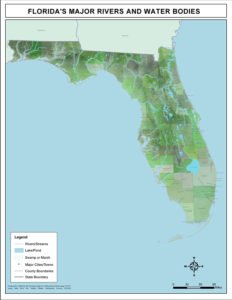
An integral aspect of the inception and evolution of Florida’s Public Trust Doctrine lies in the constitutional underpinnings that explicitly define the state’s sovereignty over navigable waters. Transitioning to historical context, in 1845, Florida was granted statehood, admitted to the Union, and simultaneously received title to all lands beneath navigable waters by its sovereignty.
Furthermore, Article X, §11, of the state constitution serves as a cornerstone. It articulates the nature of Florida’s ownership and the purpose for which it holds these lands in trust for the people. This constitutional provision plays a crucial role in shaping and safeguarding the Public Trust Doctrine.
Constitutional Framework: Article X, §11
Article X, §11 of the state constitution provides a clear, definitive statement on the sovereignty of lands, specifically those under navigable waters. The constitutional provision extends beyond ownership and emphasizes a profound duty: the state holds these lands in trust for all the people. Crucially, this ownership is grounded in the state’s sovereignty and is explicitly described as being held in trust for all the people. It states: “The title to lands under navigable waters, within the boundaries of the state, which have not been alienated, including beaches below mean high water lines, is held by the state, by virtue of its sovereignty in trust for all the people. ”
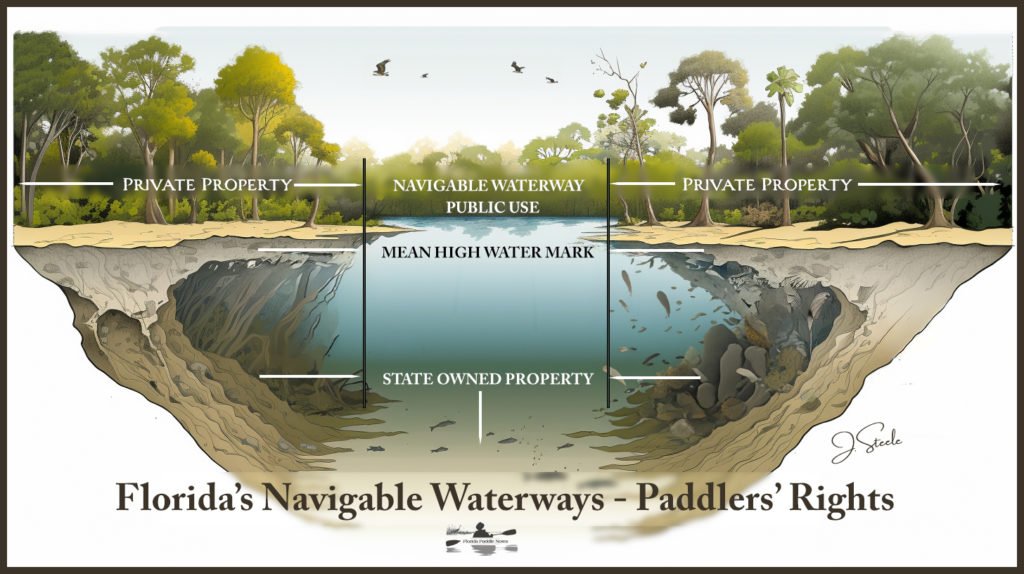
In regards to Paddlers’ Rights, a person needs to consider whether in 1845, the year Florida became a State the waterway was potentially useful for public commerce or recreation. If so, absent of additional considerations, title to the waters (including the land up to the high mean waterline) is vested in the State and NOT the property owner.
In 1979, the U.S. Supreme Court established conditions for navigable waters in the ruling of Kaiser Aetna v. the United States. (444 U.S. 164, 100 S. Ct. 383, 62 L. Ed. 2d 332). It was determined that 4 conditions had to be met…whether the body of water:
-
- is subject to the ebb and flow of the tide.
- connects with a continuous interstate waterway,
- has the navigable capacity, and
- is actually navigable.
Although not directly applicable to Florida, Florida courts have held that bodies of water much smaller than lakes and rivers also constitute navigable waters using these tests. For further reading…1972 Clean Water Act, Definition of “Navigable Waters, and The Public Trust Doctrine: Historic Protection for Florida’s Navigable Rivers and Lakes.
Lands Under Navigable Waters
The constitutional language precisely identifies the scope of the state’s ownership—”lands under navigable waters.” This includes the submerged lands and extends to beaches below mean high water lines. The constitutional framers intended to encompass a comprehensive understanding of navigable waters, emphasizing the state’s responsibility for these critical natural resources.
Held in Trust for All the People
The constitutional provision goes beyond mere ownership and emphasizes a profound duty—the state holds these lands in trust for all the people. This trust obligation reinforces the public nature of navigable waters and underscores the state’s commitment to managing and preserving these lands for the collective benefit of its citizens.
Role of the Board of Trustees
To operationalize this constitutional mandate, the administration, management, and control of these lands are explicitly vested in the Board of Trustees of the Internal Improvement Trust Fund. This institutional framework ensures that the state fulfills its duty to protect and preserve navigable waters in accordance with the Public Trust Doctrine.
Constitutional Continuity
Article X, §11 of the constitution stands as a testament to the state’s enduring commitment to the principles of the Public Trust Doctrine. It provides a constitutional foundation for the legal framework governing navigable waters, shaping the state’s approach to ownership, public access, and responsible use.
Influence on Legal Interpretation
In legal matters pertaining to navigable waters, courts often turn to the constitutional provision in Article X, §11 as a guiding principle. This constitutional framework not only defines state ownership but also reinforces the overarching theme of public trust, influencing judicial interpretation and decisions related to the use and protection of navigable waters.
Conclusion
The constitutional provision in Article X, §11 stands as a crucial component of Florida’s Public Trust Doctrine, grounding the state’s ownership of navigable waters in sovereignty and trust. This constitutional commitment guarantees access and preservation of vital natural resources, benefiting all citizens and aligning with the responsible stewardship principles of the Public Trust Doctrine.
Legalities of Blocking Spring Runs…
Balancing Private Property Rights, Public Access, Paddlers’ Rights.
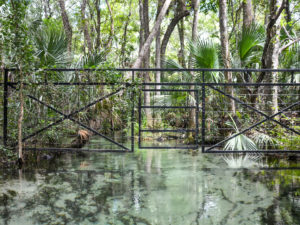
Blocking spring runs presents a complex and contentious issue, often requiring a delicate balance between private property rights and the public’s interest in accessing and enjoying navigable waters. Spring runs, with their unique ecological and recreational significance, have become focal points in legal disputes. This section examines the legal landscape and relevant statutes, shedding light on the intricacies of this multifaceted challenge.
Private Property Rights
Understanding Landownership Beneath Florida’s Waterways Surface
Riparian Rights Overview
Riparian rights, granted to landowners along water bodies like rivers and lakes, extend from upland boundaries to the water’s edge in Florida. Traditionally associated with riparian land ownership, these rights aim to balance private interests with public use.
While offering exclusive use, riparian rights aren’t absolute. They are limited by the doctrine of reasonable use. Landowners must exercise these rights without infringing on others’ rights or violating the Public Trust Doctrine, ensuring a balance between private and public interests.
Sovereign Ownership of Submerged Lands
In Florida, recognizing that submerged lands, including spring runs, belong to the state is crucial. This sovereign ownership extends to lands beneath the water’s surface. While riparian landowners have rights related to upland properties, submerged lands remain state-owned. Exclusive use in riparian rights pertains to surface rights, not submerged land ownership.
Navigational Easements
Public navigational easements are a crucial aspect of riparian rights. These easements grant the public the right to navigate and use navigable waters for lawful purposes. While landowners retain certain exclusive rights, the existence of navigational easements ensures that public access is preserved and protected.
Legal Responsibilities
Riparian landowners also bear legal responsibilities, including the obligation to avoid actions that would unreasonably interfere with the rights of others. This includes considering the impact of developments, structures, or activities on the ecological health of waterways and neighboring properties.
Balancing Private Rights and Public Interests
The challenge lies in striking a balance between the private property rights of riparian landowners and the public’s interest in accessing and using navigable waters. Legal disputes often arise when landowners’ actions are perceived to unreasonably impede public access or adversely affect the ecological integrity of water bodies.
Paddlers’ Rights on Navigable Waters…
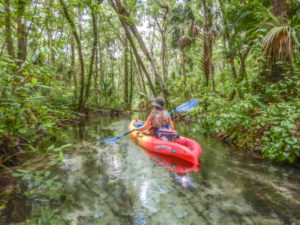
Paddlers, including kayakers, canoeists, and paddleboarders, contribute to the vibrant recreational tapestry of Florida’s navigable waters. As they embark on waterborne journeys, a nuanced interplay of legal rights and responsibilities comes into play. This section delves into the specific Paddlers’ Rights, emphasizing the legal framework that governs their activities on Florida’s waterways.
Right to Navigate and Recreation
Paddlers, by virtue of the Public Trust Doctrine, have the fundamental right to navigate navigable waters for recreational purposes. This includes the freedom to paddle along rivers, springs, and other water bodies, experiencing the natural beauty and ecological diversity that Florida’s waterways offer.
Public Access Points
Paddlers have the right to access navigable waters from public access points, such as boat ramps and designated launch areas. Ensuring the availability of these access points is essential for facilitating paddlers’ rights and promoting responsible recreational use of water resources.
Limitations on Private Restrictions
While private landowners hold certain rights along the water’s edge, they cannot unduly restrict paddlers’ rights guaranteed by the Public Trust Doctrine. Paddlers have the right to navigate through navigable waters, even if they pass through areas adjacent to private properties, provided they do so responsibly and without causing undue interference.
Restrictions on Excessive Noise and Speed
Paddlers’ Rights are, however, subject to reasonable regulations that promote safety and environmental conservation. Local ordinances may regulate factors such as excessive noise or speed to ensure a balance between recreational activities and the well-being of both paddlers and the surrounding ecosystem.
Examples of River Law court decisions in Florida…
There are several Florida court cases involving Riparian Rights, Navigable Waters, The Florida Public Trust Doctrine and the public’s right to use navigable waterways. Researching these cases was tough, as many of them were behind a ‘firewall’ that involved paying for access to them. However in this article “SOVEREIGNTY LANDS IN FLORIDA: IT’S ALL ABOUT NAVIGABILITY (PART I)” by the Florida Bar Journal, there are several cases listed if you care to read about them. Just for sampling purposes I included a few of them below…
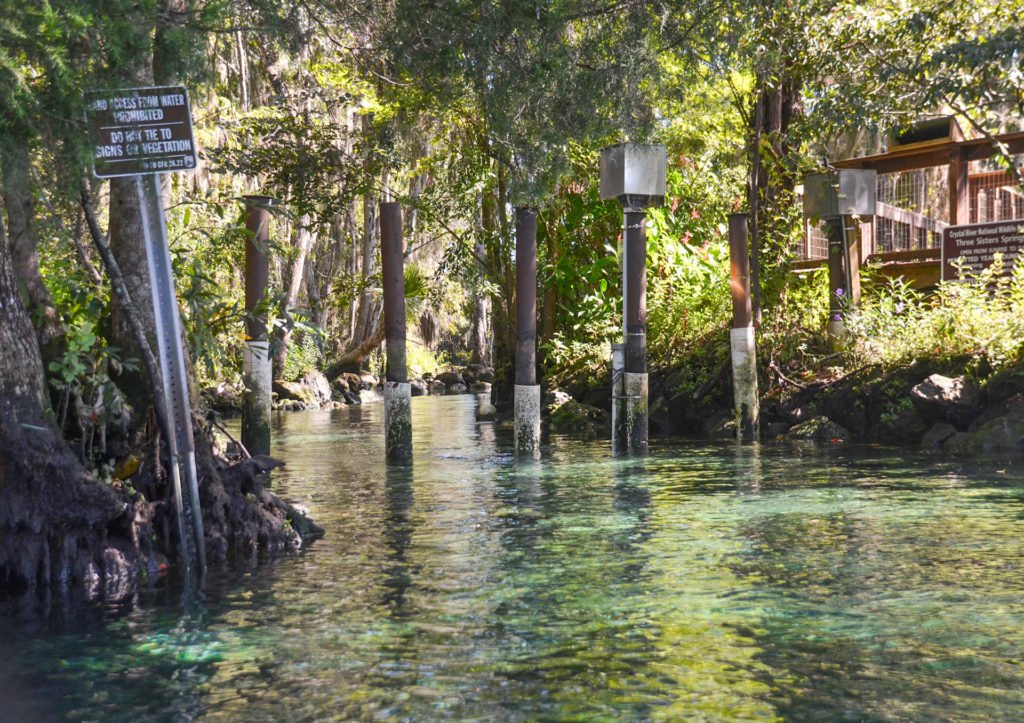
Goodman v. City of Crystal River, 669 F. Supp. 394 (M.D. Fla. 1987) – This case involves the debate of whether or not Three Sisters Springs and the Spring Run are navigable waterways and whether or not the land owner has the right to block off the spring run. In the end it was determined the run and springs were navigable waterways and could not be blocked off from public use. The plaintiff was granted permit No. 82F-1059 (defendant’s exhibit 5) by the Corps of Engineers to place 6-inch-diameter wooden pilings, 46 inches apart center to center, at the mouth of the spring run to restrict the access of larger motorized boats without inhibiting the access of small boats, canoes and kayaks.
The case of Broward v. Mabry (50 So. 826, 58 Fla. 398), decided by the Florida Supreme Court in 1909, dealt with the ownership of the beds of navigable waters in Florida. The key points of the case are:
-
- Issue: The ownership of the land under navigable waters in Florida, specifically the Internal Improvement Fund managed by the Trustees (Broward et al.).
- Parties: Elbert N. Mabry (plaintiff) vs. N. B. Broward and others, as Trustees of the Internal Improvement Fund (defendants).
- Lower court: Circuit Court of Leon County ruled in favor of Mabry.
- Supreme Court ruling: Partially affirmed and partially reversed the lower court decision.
- Reasoning: The court applied the common law principle that the state holds title to the beds of navigable waters in trust for the people. This right extends to both tide and fresh waters, regardless of the presence of tides. The state’s ownership, however, is not for individual ownership but for the public’s benefit for navigation, commerce, fishing, bathing, and other lawful uses of the water. While the federal Constitution grants certain rights to the federal government, the states retain primary ownership and responsibility for these submerged lands.
Further implications: This case established a significant precedent for the public trust doctrine in Florida regarding the ownership and use of navigable waterways. It clarified the state’s role as a trustee for the people’s rights and limited the ability of private individuals to claim ownership of submerged lands.
Baker v. State, 87 So. 2d 497 (Fla. 1956)
-
- Ruled that a 15-feet wide creek was navigable despite being traversable only by canoe or small boat. Established a low threshold for navigability in Florida.
A familiar example of Paddlers’ Rights vs Private Property Rights
Indian Creek/Gissy Spring
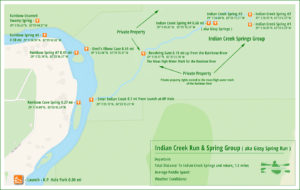
If you’ve paddled the beautiful Rainbow River in Marion County near Dunellon, Fl, you have probably noticed, or even explored, a narrow spring run flowing into the river just a 1/4 mile North of K.P. Hole County Park. This is Indian Creek, flowing from Gissy Spring.
Indian Creek flows 0.40 miles West from its source, Indian Spring, now known as Gissy Spring. It was purchased by successful investor/developer Jim Gissy in 2006.
My original post on Gissy Spring and Indian Creek
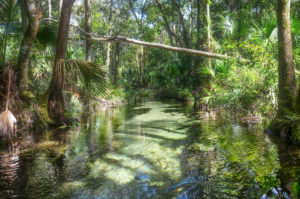
On October 16, 2019, I posted information of a paddle I made to Gissy Spring which flows into the Rainbow River via Indian Creek. In that post, as in all my posts, I provide enough information describing the paddle, to include a map, as well as details and photographs of the flora and fauna.
A key feature of that post was a discussion of Florida Navigable Waters, paddlers’ rights and whether the water, and the land beneath, are actually private property. I provided several links to Florida’s laws and descriptions of navigable waters and included several references to the land that bordered the spring and run as being private property. The post was my personal documentation of paddling the run, as well as my understanding of ‘navigable waters’ from the documentation I researched.
Following that post in Oct, six months later in April of 2020, I received an email from Kathryn Gissy Saft Esq., a lawyer representing Jim Gissy’s interests. The email revolves around the above-mentioned post from October 16, 2019. Ms. Saft asserted that the spring and run did not qualify as navigable waters under Florida law and were therefore private property. Despite presenting a 2006 Boundary Survey for Gissy Springs, confirming ownership of the waterway was inconclusive. The survey explicitly excluded a determination of water rights, raising questions about the actual status of navigability and private ownership.
In response, Ms. Saft wrote back “immediately remove the aforementioned blog post and confirm your compliance with this demand within three (3) business days“, or “face consequences of being responsible for anyone paddling up there and stealing personal property or equipment“.
Indian Creek Gallery
This obviously leaves the issue for Indian Creek still unsettled for paddlers. This could have been easily settled if Ms. Saft would have provided information that deeds to Mr. Gissy the sovereign land of Florida beneath Indian Creek and the Indian Springs. Documentation must also show that Indian Creek is not a navigable waterway.
As paddlers, we often run into situations like this and it is always helpful to understand our public rights on Florida’s waterways. My original post will remain up, though I will gladly amend it when presented with the information needed. This situation underscores the complex intersection of navigability, private property, and paddlers’ rights in Florida’s waterways.
![]() Important Information: When you run into situations like this remain in your kayak or in mid-stream as this is private property up to and along the mean high watermark of the Rainbow River.
Important Information: When you run into situations like this remain in your kayak or in mid-stream as this is private property up to and along the mean high watermark of the Rainbow River.
A second familiar example…House Spring at Crystal River
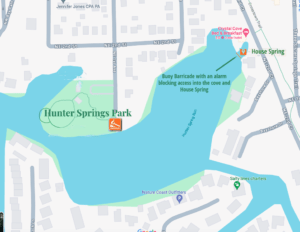
Just East of Hunter Spring Park, a popular launch for paddlers is a small cove or bay called Hunter Springs Run. On the East side of that run is another small alcove of water that leads up to Crystal Cove Bread & Breakfast. In the spring run just before the small cove, is Jurrasic Spring. Just beyond that spring, inside the small cove sits House Spring. Access to this spring as well as the small cove is blocked by roped buoys, that when touched, set of an alarm in the adjacent home.
Someone will definitely come out and tell you that you do not have access beyond the buoys. It’s not worth arguing about, but technically the resident could be asked to produce documentation that the State of Florida has deeded this sovereign land to the private property owner, or, at the least has granted permission to restrict access due to environmental concerns.
It’s just another scenario where both property owners as well as paddlers should be aware of their riparian rights and the use of navigable waterways.
A third familiar example…Big Blue Spring on the Withlacoochee River in Citrus County
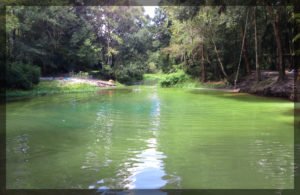
Another test of Paddlers’ Rights happened along the Withlacoochee River in Citrus County. Back in the late 60’s a dam was built of ‘fill’ around Big Blue Spring. Residents felt that as owners of the land surrounding the spring they actually owned the spring and enjoyed their own private swimming hole for more than 20 years.
The dam was breached, and the property owners heckled and verbally abused paddlers coming into the spring, calling them trespassers. The case went to court and the private property owners lost to those wishing to use Florida’s navigable waters for recreation. You can read the article Big Blue Spring access not just for a few, here. Tampa Bay Times 1990, 2005.
This case was after the residents of Gum Slough put a barrier of fallen trees across the waterway to prevent paddlers from coming up to the several springs in the slough. The private property owners also lost that case.
Conclusion
Understanding paddlers’ rights on Florida’s navigable waters requires appreciation for the Public Trust Doctrine, local regulations, and the delicate balance between individual freedoms and collective responsibilities. Homeowners are advised to respect public access rights and refrain from confronting individuals entering the area, but they can report any disturbances to authorities.
These controversies highlight that, in general, Florida waterways belong to the public, and property ownership does not grant the right to bar others from enjoying the water. Paddlers play a crucial role in fostering a sustainable and inclusive water recreation culture, ensuring that the enjoyment of these natural resources endures for current and future generations.
Recommendations for Preserving Paddlers’ Rights…
Fostering Responsible Recreation
 Preserving paddlers’ rights necessitates a multifaceted and collaborative approach emphasizing education, communication, and adaptive management. Here, we explore specific recommendations aiming to foster responsible recreation, mitigate conflicts, and ensure the sustainable enjoyment of these natural resources.
Preserving paddlers’ rights necessitates a multifaceted and collaborative approach emphasizing education, communication, and adaptive management. Here, we explore specific recommendations aiming to foster responsible recreation, mitigate conflicts, and ensure the sustainable enjoyment of these natural resources.
Education and Awareness
Promoting Understanding of Rights and Responsibilities
Develop educational programs to enhance paddlers’ awareness of their rights under the Public Trust Doctrine and navigational easements. Emphasize responsible and respectful paddling practices to minimize conflicts with private landowners.
Resources:
Community Outreach Initiatives:
Engage with local communities, paddling organizations, and environmental groups to raise awareness about the importance of paddlers’ rights and the ecological significance of navigable waters. Foster a sense of shared responsibility for preserving these resources.
Collaboration and Mediation:
Establishing Dialogue Platforms:
Facilitate open communication between paddlers and private landowners through community forums, workshops, or advisory boards. Establishing a collaborative dialogue can help address concerns, find common ground, and build understanding. This can be done using the above three resources cited, Florida Paddle Trails Association, Florida’s Designated Paddling Trails, and Paddle Florida.
Mediation Services:
Explore the use of mediation services to resolve disputes amicably. Mediation can provide a neutral platform for paddlers and landowners to discuss concerns, negotiate solutions, and reach mutually agreeable outcomes. This often avoids protracted legal battles.
County Mediation Programs:
Most counties in North Central Florida have established mediation programs that can handle a variety of disputes, including riparian rights. These programs are typically administered by the local court system and offer mediation services at low or no cost. Here are some links to the websites of some county mediation programs in North Central Florida.
-
- Alachua County: https://circuit8.org/departments-services/mediation/
- Bradford County: https://bradfordmediation.com/schedule-now
- Columbia County: https://thirdcircuitfl.org/court-mediation/
- Gilchrist County: https://www.briangilchrist.com/use-mediation-services/
- Levy County: https://circuit8.org/departments-services/mediation/
- Marion County: https://www.circuit5.org/programs-services/mediation-and-alternative-dispute-resolution/marion-county-mediation-services/
- Putnam County: https://putnamclerk.com/
- Suwannee County: https://www.leomediationsllc.com/
Private Mediation Services:
In addition to county programs, there are also a number of private mediation providers in North Central Florida who specialize in environmental disputes. These providers may be a good option if you are looking for a mediator with specific expertise in riparian rights law. Here are a few examples:
-
- Florida Dispute Resolution Center: https://www.flcourts.gov/Resources-Services/Alternative-Dispute-Resolution
- North Florida Community Mediation Center: https://www.resolutioncenter.org/
- The Roth Law Group: http://www.rothlawgroupny.com/
Additional Resources:
-
- The Florida Department of Environmental Protection (DEP) also has a website with information on riparian rights in Florida: https://www.llw-law.com/wp-content/uploads/2016/04/General-Overview-of-Riparian-Rights-in-Florida.pdf
- The University of Florida Water Resources Institute also has a website with information on riparian rights and water law in Florida: https://waterinstitute.ufl.edu/
Benefits of Using Mediation:
-
- Mediation can be a more cost-effective and time-efficient way to resolve disputes than litigation.
- It can help to preserve relationships between the parties involved in the dispute.
- Mediation usually results in more creative and flexible solutions than litigation.
Clear Signage and Access Points:
Strategic Signage
Install clear signage at public access points and along waterways to inform paddlers of their rights, responsibilities, and any specific regulations. Proper signage can help prevent unintentional trespassing and guide paddlers to navigate responsibly.
Enhancing Public Access Points
Invest in well-maintained public access points, including boat ramps and launch areas. Improved access infrastructure encourages paddlers to use designated entry points, minimizing conflicts with private landowners and enhancing the overall paddling experience.
Legislative Review and Updates:
Regular Legislative Review
Conduct periodic reviews of existing legislation related to navigable waters, Riparian rights, and paddlers’ rights. Identify areas that may require clarification, updates, or additional protections to adapt to evolving recreational practices and environmental concerns.
Legislation Supporting Responsible Recreation
Propose and advocate for legislation that supports responsible paddling practices, including provisions for public access, navigational easements, and environmental conservation. Seek input from paddling communities, landowners, and environmental experts during legislative discussions.
Local Government:
County Commissions: Each county in North Central Florida has a Board of County Commissioners responsible for local legislation and ordinances. Contact your county commissioners and express your desire for legislation promoting responsible paddling, public access, and environmental protection. Attend commission meetings and public hearings to voice your support for specific proposals.
Here are some direct links to the county commission websites in North Central Florida:
-
- Alachua County: https://alachuacounty.us/govt/pages/govt.aspx
- Bradford County: https://www.bradfordcountyfl.gov/commissioners
- Columbia County: https://www.columbiacountyfla.com/County_Commissioners.asp
- Gilchrist County: https://gilchrist.fl.us/
- Levy County: https://www.levycounty.org/government/commissioners/index.php
- Marion County: https://www.marionfl.org/my-commissioners
- Putnam County: https://main.putnam-fl.com/
- Suwannee County: https://suwanneecountyfl.gov/
City Councils: Many cities in North Central Florida have jurisdiction over waterways within their boundaries. Engage with your city council members and advocate for ordinances promoting responsible paddling practices, such as designated launch points, signage for sensitive areas, and educational campaigns.
-
- Jacksonville: https://www.jacksonville.gov/city-council.aspx
- Gainesville: https://www.gainesvillefl.gov/City-Commission
- Lake City: https://www.lcfla.com/community/page/city-council
- Ocala: https://www.ocalafl.gov/
- Palatka: https://palatka-fl.gov/130/Departments
These websites typically contain information about the council members, their meetings, agendas, and minutes, as well as contact information. You can also find information about city government services and programs on these websites.
State Legislature:
Florida House of Representatives and Senate: Contact your state representatives and senators and urge them to introduce or support legislation that addresses responsible paddling practices in North Central Florida. Focus on issues like public access easements on navigable waterways, funding for waterway conservation programs, and regulations to minimize paddler impact on sensitive ecosystems.
State Agencies:
-
- Florida Department of Environmental Protection (DEP): The DEP plays a crucial role in managing Florida’s waterways and ecosystems. Collaborate with the DEP to develop responsible paddling guidelines, advocate for increased enforcement of existing regulations, and support initiatives promoting waterway conservation.
- Florida Fish and Wildlife Conservation Commission (FWC): The FWC is responsible for managing fisheries and wildlife in Florida. Work with the FWC to develop educational programs for paddlers on minimizing their impact on wildlife and sensitive habitats.
- Suwannee River Water Management District (SRWMD): The SRWMD manages the water resources of the Suwannee River Basin. Partner with the SRWMD to develop responsible paddling guidelines for the Suwannee River and its tributaries, and advocate for funding for conservation programs in the basin.
Community Engagement
Organize Public Forums: Host community forums to bring together paddlers, landowners, environmental experts, and government officials to discuss the challenges and opportunities for responsible paddling in North Central Florida. These forums can generate valuable insights and build consensus around potential legislative solutions.
Educate the Public: Develop educational materials and outreach programs to inform paddlers about responsible practices, sensitive ecosystems, and local regulations. This can help to prevent unintentional harm to the environment and build public support for responsible paddling legislation.
By engaging with local and state government, collaborating with relevant agencies and non-profits, and fostering community dialogue, you can play a crucial role in advocating for legislation that supports responsible paddling practices, public access, and environmental conservation in North Central Florida. Remember, effective advocacy requires a multi-pronged approach that combines grassroots organizing, data-driven arguments, and collaboration with diverse stakeholders.
Remember, advocating for legislation takes time and effort, but the long-term benefits for responsible recreation and environmental protection are significant. Keep advocating, keep educating, and keep working with your community to ensure that North Central Florida’s waterways remain accessible and healthy for generations to come.
Environmental Stewardship Programs
Collaborative Conservation Initiatives
Encourage partnerships between paddling organizations, environmental groups, and governmental agencies to implement conservation programs. These initiatives can focus on protecting water quality, preserving natural habitats, and raising awareness about the ecological importance of navigable waters.
Local Environmental Groups:
-
- Suwannee Riverkeeper: This non-profit organization works tirelessly to protect the Suwannee River and its tributaries. Volunteer at river cleanups, attend educational workshops, or donate to their cause.
- St. Johns Riverkeeper: Similarly dedicated to the St. Johns River, this group offers volunteer opportunities, advocacy campaigns, and educational programs to ensure the river’s health.
- WWALS Watershed Coalition, Inc. (WWALS): WWALS advocates for conservation and stewardship of the surface waters and groundwater of the Suwannee River Basin and Estuary, in south Georgia and north Florida, among them the Withlacoochee, Willacoochee, Alapaha, Little, Santa Fe, and Suwannee River watersheds, through education, awareness, environmental monitoring, and citizen activities.
Volunteer Clean-Up Events:
Organize volunteer-driven clean-up events along waterways. Engaging paddlers in environmental stewardship activities fosters a sense of responsibility and appreciation for the natural resources they enjoy. Paddlers in Florida can find organizations that organize volunteer-driven clean-up events along waterways through the following resources:
-
- VolunteerCleanup.Org – This website allows users to find a list of upcoming cleanups organized by various third-party partners, non-profits, local businesses, or individual volunteer leaders. Users can input their address or zip code to locate clean-up events in their area.
- Keep Florida Beautiful – This organization and its affiliates in Florida participate in various clean-up initiatives, including the Great American Cleanup, International Coastal Cleanup Day, and more. They offer volunteer opportunities across the state, allowing individuals to get involved in community clean-up efforts.
- Florida Paddling Trails Association -Supports, improves, and maintains water trails, promotes environmental protection along the trails, serves as a resource and voice for paddlers, and promotes paddling safety and education.
By engaging with these organizations and platforms, paddlers can participate in and support volunteer-driven clean-up events along Florida’s waterways, contributing to the preservation and protection of the state’s natural resources.
Research and Data Collection
Environmental Impact Studies
Support research initiatives and environmental impact studies to assess the ecological impact of paddling activities. Utilize scientific data to inform regulations, management strategies, and conservation efforts, ensuring a balance between recreation and environmental preservation.
Conclusion…
Preserving paddlers’ rights necessitates a collaborative approach that emphasizes education, communication, and adaptive management. Preserving access to these natural waterways requires a delicate balance between private property rights and the public’s enjoyment of these resources.
 FAQ’s
FAQ’s
Here is a list of common FAQs (Frequently Asked Questions) that paddlers might inquire about concerning their rights on navigable waters:
- Do I have the right to paddle on any navigable water in Florida?
- Can private landowners restrict my access to navigable waters?
- What is the Public Trust Doctrine, and how does it apply to paddlers?
- Are there specific regulations or laws governing paddling activities in Florida?
- Can I paddle through areas adjacent to private properties?
- Are there designated launch points for paddlers?
- Can private landowners ask paddlers to leave the water adjacent to their property?
- What should I do if I encounter a dispute with a private landowner?
- Are there any restrictions on paddling speed or noise level?
- How can I contribute to environmental conservation while paddling?
- How can I stay updated on changes in paddling regulations or rights?
- What is a navigational easement?
- Can Florida State Parks block off spring runs in Florida?
- In Florida, does a waterway have to be navigable along its entire course? What if there is a small section that requires one to portage, does that negate it from being navigable?
- When paddling on Florida’s rivers many landowners block off portions of the river and side runs, like spring runs, to prevent paddlers from getting close to their property. Is this legal?
Q: Do I have the right to paddle on any navigable water in Florida?
A: Yes, navigable waters are considered public resources held in trust by the state for the benefit of the public. Paddlers generally have the right to navigate on navigable waters.
Q: Can private landowners restrict my access to navigable waters?
A: Private landowners have certain rights, but they cannot unduly restrict access to navigable waters. Paddlers should respect private property rights while navigating responsibly.
Q: What is the Public Trust Doctrine, and how does it apply to Paddlers’ Rights?
A: The Public Trust Doctrine establishes that navigable waters are held in trust by the state for the public’s benefit. Paddlers have rights under this doctrine to access and enjoy navigable waters.
Q: Are there specific regulations or laws governing paddling activities in Florida?
A: Yes, there are regulations and laws that may govern paddling activities, including navigational easements, environmental regulations, and safety guidelines. Familiarize yourself with these rules.
Q: Can I paddle through areas adjacent to private properties?
A: Paddlers have the right to navigate through navigable waters, even if they pass through areas adjacent to private properties. Respect private property rights and avoid causing undue interference.
Respect private property rights and avoid causing undue interference.
Q: Are there designated launch points for paddlers?
A: Yes, there are often designated public access points, such as boat ramps and launch areas, where paddlers can access navigable waters. Follow signage and use these points responsibly.
Q: Can private landowners ask paddlers to leave the water adjacent to their property?
A: Private landowners may ask paddlers to leave if there are reasonable concerns, but paddlers have the right to navigate through navigable waters. Communication and understanding Paddlers’ Rights are key in such situations.
Q: What should I do if I encounter a dispute with a private landowner?
A: Try to engage in a calm and respectful conversation to understand concerns. If needed, seek mediation services to resolve disputes amicably. Consult legal resources if conflicts persist.
Q: Are there any restrictions on paddling speed or noise level?
A: Local ordinances may regulate factors like excessive noise or speed on the water. Be aware of and comply with these regulations to ensure a safe and enjoyable paddling experience.
Q: How can I contribute to environmental conservation while paddling?
A: Practice Leave No Trace principles, participate in clean-up events, and support environmental stewardship initiatives. Be mindful of wildlife and ecosystems to minimize ecological impact.
Q: How can I stay updated on changes in paddling regulations or Paddlers’ Rights?
A: Regularly check official state websites, join paddling organizations, and stay informed through online forums and community platforms dedicated to water recreation.
Q: What is a navigational easement?
A: A navigational easement refers to a legal right that allows individuals or entities to use a waterway for navigation purposes, typically for boating or other waterborne activities. This easement grants the right to travel across a specific water body even if the land surrounding it is privately owned. Navigational easements are often established to ensure public access to navigable waters and to uphold the right of passage for activities like boating, fishing, or recreation. The terms and conditions of navigational easements can vary based on local laws and regulations.
Q: Can Florida State Parks block off spring runs in Florida
A: The management of spring runs in Florida, including the decision to block a navigable waterway, is typically the responsibility of multiple government agencies. Florida’s springs are managed by five government agencies, with the Florida Department of Environmental Protection being the primary agency involved in protecting and managing the state’s springs.
Additionally, the Division of Environmental Assessment and Restoration coordinates the monitoring and assessment of efforts to protect and restore Florida springs. These agencies work together to develop water quality restoration plans, such as Basin Management Action Plans (BMAPs), which include protections for Florida’s springs.
Florida State Parks can block off spring runs in Florida. For example, Blue Spring State Park closes the spring run to water activities during manatee season to protect the manatees. This is a common practice in many state parks to ensure the safety of wildlife and habitat. Many other state parks and wildlife management refuges’ do the same.
Q: In Florida, does a waterway have to be navigable along its entire course? What if there is a small section that requires one to portage, does that negate it from being navigable?
A: In Florida, a waterway does not have to be navigable along its entire course to be considered navigable. The presence of a small section that requires portage does not necessarily negate its navigability. Navigability is determined based on various factors, including historical and practical considerations, the capability of the water body to be used for transportation, and its suitability for practical general public use.
Q: When paddling on Florida’s rivers many landowners block off portions of the river and side runs, like spring runs, to prevent paddlers getting close to their property. Is this legal as does it interfere with Paddlers’ Rights?
A: In Florida, the Public Trust Doctrine and state law dictate that the title to lands under navigable waters, including rivers and spring runs, is held by the state in trust for all the people. While paddlers must respect private property along waterways, they have the right to navigate on the water, which is considered public and open to everyone. Therefore, blocking off portions of a river or spring run to prevent paddlers from getting close to private property may not be legal, as the public has the right to navigate on the waterways. There are always exceptions, as in state parks where the protection of an ecosystem is at stake.
More Information…
Florida’s Navigable Waters…
- 1972 Clean Water Act…
- The Public Trust Doctrine: Historic Protection for Florida’s Navigable Rivers and Lakes…
- Sovereignty Lands in Florida – It’s All About Navigability – Florida Bar Journal…
- Revisions to the Regulatory Definition of “Navigable Waters”…
- Florida’s State Land Authorization…
Riparian Rights…
- Florida Statutes – Riparian Rights…
- Nature and Status of Riparian Rights in Florida – UF College of Law…
- General Overview Of Riparian Rights in Florida…
![]()

